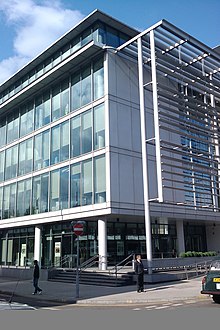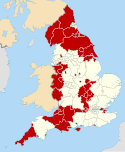Nottingham City Council
Nottingham City Council | |
|---|---|
 | |
| Type | |
| Type | |
| Leadership | |
Mel Barrett since September 2020[3] | |
| Structure | |
| Seats | 55 councillors |
Political groups |
|
Length of term | 4 years |
| Elections | |
| First past the post | |
Last election | 4 May 2023 |
Next election | 2027 |
| Meeting place | |
 | |
| Council House, Old Market Square, Nottingham, NG1 2DT | |
| Website | |
| www | |
Nottingham City Council is the local authority for Nottingham, a unitary authority with city status. Nottingham is in the ceremonial county of Nottinghamshire, England, but as a unitary authority the city council is administratively independent from the surrounding Nottinghamshire County Council. The city council consists of 55 councillors, representing a total of 20 wards, elected every four years. The council is led by David Mellen, of the majority Labour Party.[4][5]
History
Nottingham was an ancient borough. The earliest known borough charter was issued by Henry II sometime between 1155 and 1165; that charter did not purport to create the borough, but instead confirmed to it the rights that it had already held in the time of Henry I (reigned 1100–1135). The borough was governed by a corporation, also known as the town council. A later charter of 1284 granted the borough the right to appoint a mayor.[6]
In 1836 Nottingham became a municipal borough under the Municipal Corporations Act 1835. When elected county councils were established in 1889 under the Local Government Act 1888, Nottingham was considered large enough to provide its own county-level services and so it was made a county borough, independent from Nottinghamshire County Council.[7]
Nottingham was awarded city status on 7 August 1897, allowing the corporation to call itself Nottingham City Council.[8] In 1928 the city council was given the right to appoint a lord mayor.[9]
In 1974 Nottingham became a non-metropolitan district under the Local Government Act 1972, becoming a lower tier authority with Nottinghamshire County Council providing county level services in the city for the first time. The city kept the same outer boundaries, but did gain an exclave from Nottinghamshire containing the Shire Hall.[10][11] Nottingham kept its borough and city statuses and its lord mayoralty.[12][13]
Nottingham became a unitary authority on 1 April 1998, regaining its independence from Nottinghamshire County Council.[14]
Governance
As a unitary authority, Nottingham City Council has the functions of a county council and district council combined. There are no civil parishes in Nottingham, which has been an unparished area since the reforms of 1974.[15]
Political control
The council has been under Labour majority control since 1991.
Political control of the council since the 1974 reforms took effect has been as follows:[16]
Non-metropolitan district
| Party in control | Years | |
|---|---|---|
| Labour | 1974–1976 | |
| Conservative | 1976–1979 | |
| Labour | 1979–1987 | |
| Conservative | 1987–1988 | |
| No overall control | 1988–1991 | |
| Labour | 1991–1998 | |
Unitary authority
| Party in control | Years | |
|---|---|---|
| Labour | 1998–present | |
Leadership
The role of Lord Mayor of Nottingham is largely ceremonial. Political leadership is instead provided by the leader of the council. The leaders since 1983 have been:[17]
| Councillor | Party | From | To | |
|---|---|---|---|---|
| Len Maynard | Labour | May 1983 | ||
| Betty Higgins | Labour | May 1983 | May 1987 | |
| Bill Bradbury[18] | Conservative | May 1987 | Nov 1988 | |
| Betty Higgins[19] | Labour | Nov 1988 | May 1993 | |
| John Taylor | Labour | May 1993 | May 1995 | |
| Graham Chapman[20] | Labour | May 1995 | 3 May 2002 | |
| Brian Parbutt | Labour | 3 May 2002 | 16 May 2003 | |
| Jon Collins | Labour | 16 May 2003 | 5 May 2019 | |
| David Mellen | Labour | 20 May 2019 | ||
Composition
Following the 2023 election, the composition of the council was:[21]
| Party | Councillors | |
|---|---|---|
| Labour | 51 | |
| Nottingham Independents | 3 | |
| Independent | 1 | |
| Total | 55 | |
The next election is due in 2027.
Premises

Full Council meetings are held at Nottingham Council House in the Old Market Square in the city centre, which was completed in 1929 and is now a Grade II* listed building.[22]
In 2009 the council moved its main offices to Loxley House, a modern office building on Station Street, opposite Nottingham railway station.[23]
Elections
Since the last boundary changes in 2019 the council has comprised 55 councillors representing 20 wards, with each ward electing two or three councillors. Elections are held every four years.[24]
Wards

The wards are:[24]
| Map No. | Ward | Councillors |
|---|---|---|
| 1 | Aspley | 3 |
| 2 | Basford | 3 |
| 3 | Berridge | 3 |
| 4 | Bestwood | 3 |
| 5 | Bilborough | 3 |
| 6 | Bulwell Forest | 3 |
| 7 | Bulwell | 3 |
| 8 | Castle | 2 |
| 9 | Clifton East | 3 |
| 10 | Clifton West | 2 |
| 11 | Dales | 3 |
| 12 | Hyson Green & Arboretum | 3 |
| 13 | Leen Valley | 2 |
| 14 | Lenton & Wollaton East | 3 |
| 15 | Mapperley | 3 |
| 16 | Meadows | 2 |
| 17 | Radford | 2 |
| 18 | Sherwood | 3 |
| 19 | St. Ann's | 3 |
| 20 | Wollaton West | 3 |
Arms
|
References
- ^ "Council minutes, 22 May 2023" (PDF). Nottingham City Council. Retrieved 30 June 2023.
- ^ "Council minutes, 20 May 2019" (PDF). Nottingham City Council. Retrieved 19 August 2022.
- ^ "New permanent Chief Executive for Nottingham City Council". Nottingham City Council. 18 May 2020. Retrieved 30 June 2023.
- ^ Ram, Phoebe (3 May 2019). "David Mellen is the new leader of Nottingham City Council". nottinghampost. Retrieved 5 May 2019.
- ^ "Your Councillors". nottinghamcity.gov.uk. Archived from the original on 5 March 2009.
- ^ Corporation of Nottingham (1890). Royal Charters Granted to the Burgesses of Nottingham, A.D. 1155-1712. Nottingham: Thomas Forman and sons.
- ^ "Nottingham Municipal Borough / County Borough". A Vision of Britain through Time. GB Historical GIS / University of Portsmouth. Retrieved 1 July 2023.
- ^ "The City of Nottingham: Receipt of the Royal Charter". Nottingham Daily Guardian. 13 August 1897. p. 8. Retrieved 1 July 2023.
- ^ "The Municipal Journal and Public Works Engineer". 24 February 1939.
{{cite magazine}}: Cite magazine requires|magazine=(help) - ^ "The English Non-metropolitan Districts (Definition) Order 1972", legislation.gov.uk, The National Archives, SI 1972/2039, retrieved 28 June 2023
- ^ "1:25,000 Administrative Area Map, 1953". National Library of Scotland. Ordnance Survey. Retrieved 1 July 2023.
- ^ "District Councils and Boroughs". Parliamentary Debates (Hansard). 28 March 1974. Retrieved 4 December 2021.
- ^ "No. 46255". The London Gazette. 4 April 1974. p. 4400.
- ^ "The Nottinghamshire (City of Nottingham) (Structural Change) Order 1996", legislation.gov.uk, The National Archives, SI 1996/1877, retrieved 19 August 2022
- ^ "Election Maps". Ordnance Survey. Retrieved 1 July 2023.
- ^ "Compositions calculator". The Elections Centre. Retrieved 10 August 2022.
- ^ "Council minutes". Nottingham City Council. Retrieved 19 August 2022.
- ^ "Tories take city - by a whisker!". Evening Post. Nottingham. 8 May 1987. p. 1. Retrieved 19 August 2022.
- ^ "Power switch". Evening Post. Nottingham. 4 November 1988. p. 1. Retrieved 19 August 2022.
- ^ Astill, Patrick (9 May 1995). "Jobs and security head new city leader's aims". Evening Post. Nottingham. p. 5. Retrieved 19 August 2022.
- ^ "Local elections 2023: live council results for England". The Guardian.
- ^ Historic England. "Council House, Exchange Buildings and adjoining shops and bank (1270582)". National Heritage List for England. Retrieved 10 April 2020.
- ^ Swaap, Aimee; Information Governance Office, Nottingham City Council (23 November 2010). "Loxley House - a Freedom of Information request to Nottingham City Council". whatdotheyknow.com. mySociety by UK Citizens Online Democracy. Retrieved 22 March 2018.
- ^ a b "The Nottingham (Electoral Changes) Order 2018", legislation.gov.uk, The National Archives, SI 2018/856, retrieved 19 August 2022
- ^ "East Midlands Region". Civic Heraldry of England. Retrieved 8 March 2021.

